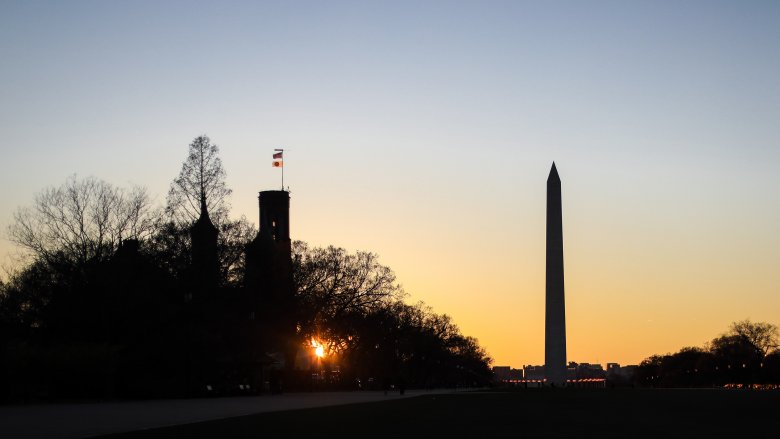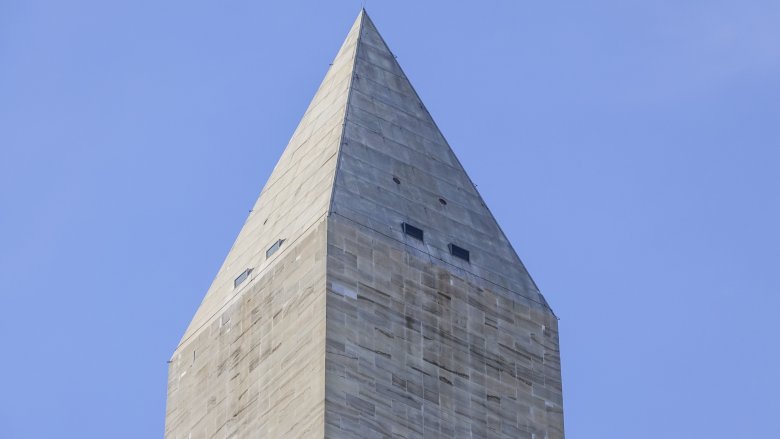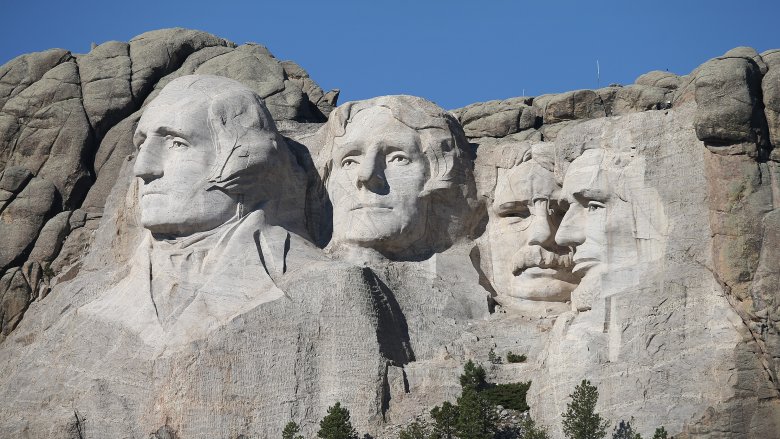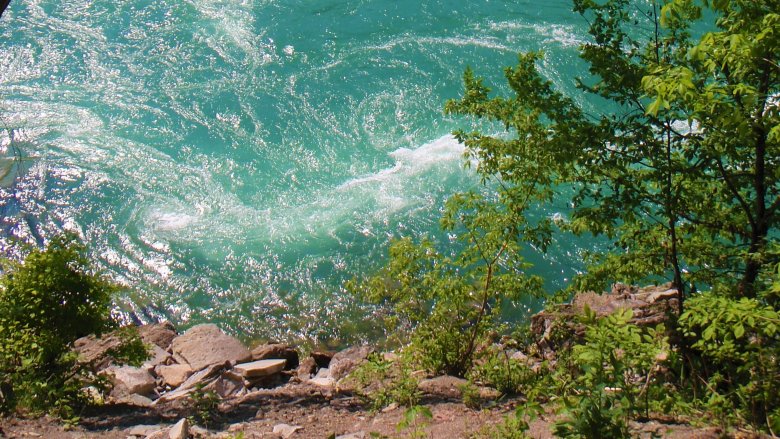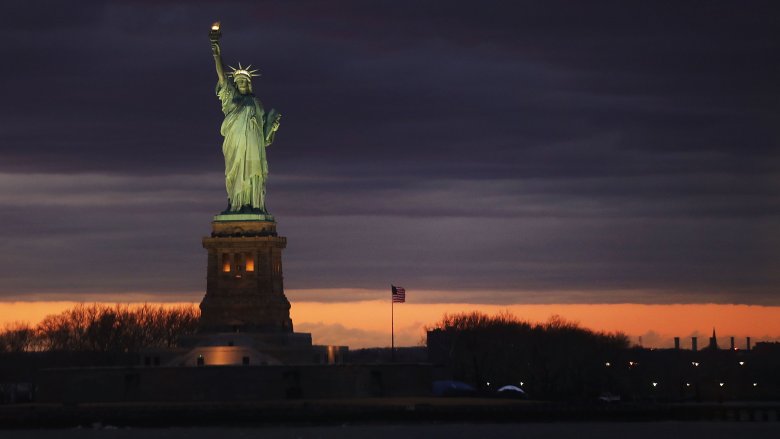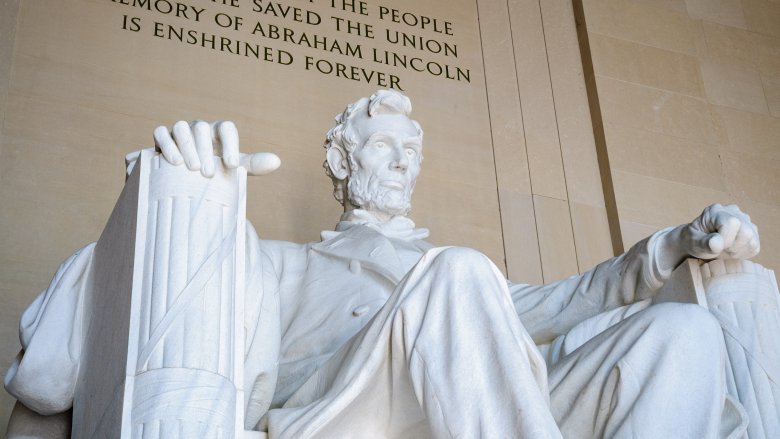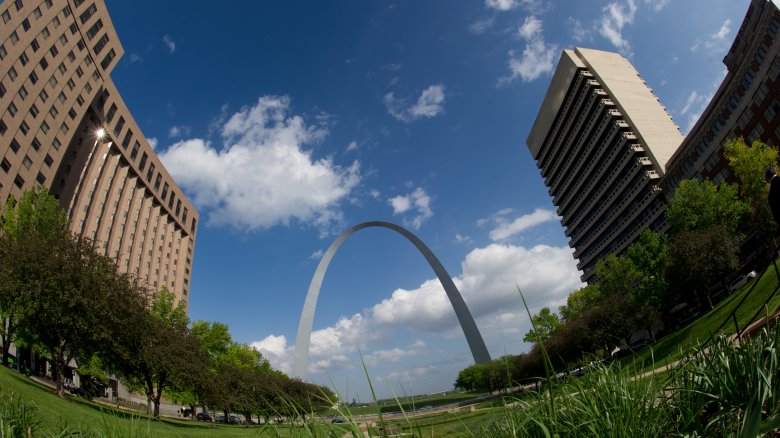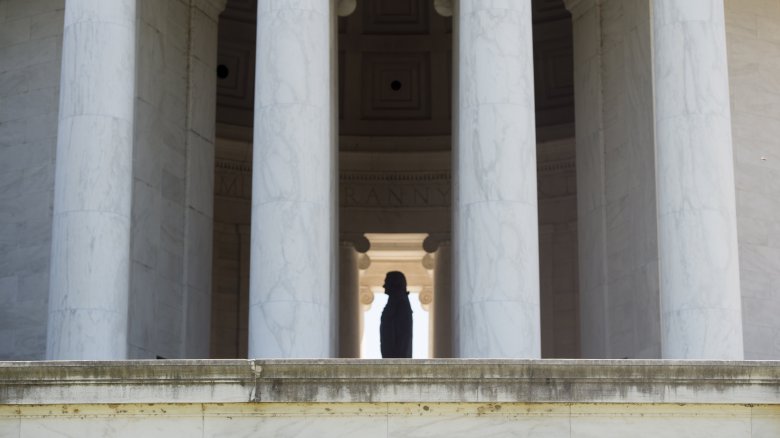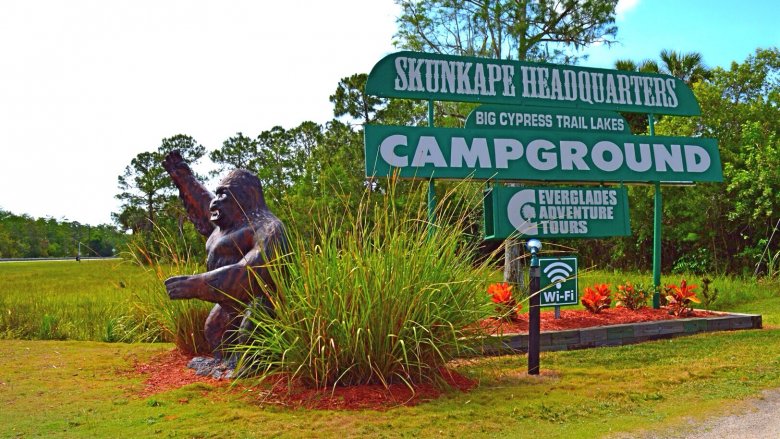Secrets Of The U.S. National Monuments
The United States' national monuments are literally some of its most famous bits of visual iconography. It's hard to imagine a cartoon representation of America without a doodle of the Statue of Liberty or Mount Rushmore. But as achingly familiar you might be with the sight of these things, even if you've never been there, it's impossible to know everything about everything, and so some mysteries and secrets remain.
The crown jewels of the U.S. National Park Service are no different. For every well-worn craggy face of Abraham Lincoln staring out at you as plain as day, there's some secret arcane symbol or hidden chamber lurking just out of sight. What follows are some of the most surprising secrets of the United States' national monuments, memorials, and parks, so get ready to see these familiar places in a whole new way. Put them all together into one long road trip, and who knows what kind of national treasure you might uncover?
The Washington Monument's shout-out to God
The Washington Monument, completed in 1884 and built as a memorial to George Washington — who was remembered at his eulogy as "first in war, first in peace, and first in the hearts of his countrymen" — is pretty mysterious in general. Despite the cachet that comes with once having been the tallest structure in the world (between the years 1884 and 1889) and the currently reigning tallest stone structure in the world, you might wonder why we decided to memorialize America's first president with an Egyptian-style obelisk, which is, to put it mildly, non-traditional iconography for America. You can set aside your Illuminati theories: it's because white people were obsessed with Egypt in the 1800s.
Other secrets remain, however. For example, the aluminum capstone of the monument, which is not visible to anyone except maybe Spider-Man, features inscriptions on each of its faces. Most of these inscriptions are just the names of architects and other dudes who worked on the monument, but the east face, the one pointed toward the rising sun, bears the Latin phrase, "Laus Deo," or "praise be to God."
At the very bottom of the monument, however, there are also a number of mystery items that were placed within the cornerstone at the beginning of the monument's construction in 1848, including a Bible, copies of the U.S. Constitution and Declaration of Independence, a portrait of Washington, a map of Washington D.C., every U.S. coin from the time, and a memoir of some dude's trip to northern Mexico for some reason.
The secret room behind Honest Abe's face
Construction on Mount Rushmore began in 1927 and the carving of the Presidents' faces took place from 1934 to 1939. The sculptor of the project, Gutzon Borglum, died in 1941, and funding for the project ran out in the same year, so the original plan to depict the four Presidents who contributed most to the foundation, preservation, and expansion of the American republic all the way down to their waists was abandoned. But that wasn't the only idea that never became reality.
According to History, Borglum's original idea was that next to Washington's head would be a giant inscription listing nine of the most significant events in American history up to that point. When someone pointed out that no one would be able to read even a giant inscription from far away, Borglum decided to instead create an enormous chamber called "the Hall of Records" that would explain why these four dudes were important enough to make a mountain look like them in case, like, aliens got confused or something.
The Hall was begun, but never finished, so now there's an empty room about 75 feet long and 35 feet high hidden behind Abraham Lincoln's head. Despite the claims of National Treasure: Book of Secrets, there is not actually a lost city of gold back there, just a handful of engraved panels hinting at Borglum's original vision. Due to safety concerns, however, the Hall is off-limits to visitors, so you'll just have to imagine what a big, empty room looks like.
The demon hole at Niagara Falls
According to the National Parks Service, the Niagara Falls National Heritage Area contains three National Historic Landmarks: the Adams Power Transformer House, the "birthplace of the modern hydroelectric power station"; the Niagara Reservation, considered the oldest state park in America; and Colonial Niagara Historic District, including Old Fort Niagara.
What they don't advertise on the parks service website is that the Falls area also contains a secret cave full of demons. The Cave of Evil Spirits, a name given to it by the Seneca tribe, lies just down the road from the Falls in Devil's Hole State Park and, according to legend, has borne a great curse for over 300 years. The story goes that French explorer René-Robert Cavelier de La Salle was warned by the Seneca not to enter the Devil's Hole, as a great Evil Spirit was trapped inside. However, La Salle became obsessed with the cave and sneaked inside, where the voice of the Evil Spirit whispered in his ear that if he returned home to Canada, wealth and fame would be his, but if he continued on his travels, he would suffer only failure and his bones would bleach in the sun.
The bit about the whispering demon is (probably) just legend, but it is 100 percent history that after his time in Niagara, La Salle continued his expedition west and was murdered by his crew, who left him to rot near the Brazos River. Believe what you will, but maybe you should just check out the transformer house.
The Everglades' secret rocket hole
There are a number of things you might expect to find in Everglades National Park: the largest subtropical wilderness in the United States, numerous waterways, an abundance of cypress trees, alligators, and, if you're lucky, a giant-sized Man-Thing guarding the Nexus of Reality. What you might not expect to stumble across in this 1.5 million acres of Floridian wetland is an abandoned secret rocket hole, complete with secret abandoned hole rocket.
According to Atlas Obscura, in the 1960s, the government used the Aerojet-Dade Rocket Facility, built on 25,000 acres in Homestead, Florida, to test various types of solid rocket fuel, including building the largest solid-fuel rocket ever made. Such tests sent hydrochloric acid spewing across the local farms and wetlands, presumably contributing to the long-standing history of trust and goodwill between the federal government and Florida swamp people.
Anyway, NASA ultimately decided to use liquid fuel for their rockets, meaning that Aerojet's raison d'etre (and their funding) was no more, so the feds just bounced, leaving history's largest solid-fuel rocket in a hole in the Everglades. The silo and other remaining structures were originally poorly covered, making access to them quite easy, but some of the structures have been taken apart and the silos have been covered with cement beams. The whole facility will eventually be buried, so if you want to make a trip out to see a giant rocket in a giant rocket hole in Florida, you should probably go now.
The coded sculpture even the CIA can't crack
While technically not a monument, Kryptos is a sculpture on the grounds of the CIA in Langley, Virginia, and it holds a fascinating secret. The sculpture displays four encrypted messages, the last of which has never been solved. As Wired explains, the sculpture, created by American artist Jim Sanborn, was dedicated on November 3, 1990, and has become a subject of obsession and fascination for both professional and amateur codebreakers in the decades since.
The first three sections of the sculpture's code were cracked separately by cryptanalysts in the NSA and CIA, as well as some random computer scientist, in the mid-1990s, but as of this writing, no one has solved the fourth section. That section is apparently key to the understanding of the whole sculpture, which, according to Sanborn, is a "riddle within a riddle." In 2006, Sanborn gave the clue that some of the 97 words in the fourth section stood for the word "Berlin," and in 2014, he gave the additional clue that the next word in the sequence spelled "clock," presumably referring to the Berlin Clock, but Sanborn added, cryptically of course, "There are several really interesting clocks in Berlin."
Sanborn, in his 70s at the time of this writing, has confirmed that if he dies before someone solves the fourth section, the solution will be passed to someone in his will. Still, if you're the kind of person who likes cracking codes, you'd better get cracking and see if you can beat the NSA. Maybe there's a treasure!
Liberty's light (with bonus feet)
The Statue of Liberty is maybe the most iconic monument in the United States, a nearly universally recognized symbol of America's professed dedication to freedom and democracy. "Liberty Enlightening the World," as the statue is more formally known, was a gift from the people of France and was dedicated in 1886. The symbolism of Liberty's "enlightenment" is made manifest by the giant torch she holds in her equally giant right hand.
It turns out that there is a room inside the torch that tourists used to be able to climb into, until 1916. That's when some German spies exploded a nearby munitions depot, which killed several people, injured hundreds, and damaged Lady Liberty's arm and torch. The damaged parts were not fixed until 1984, and the torch, which was actually completely replaced, was never reopened to the public, making the crown the highest vista from which to look out upon millions of people who believe they are the only ones to have ever tasted good pizza.
Another, less intentional secret is what the statue's feet look like, which is really only a secret because it's hard to see from most angles. It turns out she's standing on broken shackles with her right foot raised to take a step forward. According to the National Parks Service, this is to symbolize the abolition of slavery in the U.S. following the Civil War and a dedication to progress. Maybe someone should tell her to walk faster.
Bundles of secrets at the Lincoln Memorial
The Lincoln Memorial is a powerful vision of one of America's greatest Presidents, considered the Savior of the Union for his role in preserving the the United States and abolishing slavery. As such, there's a great deal of mystique surrounding the Lincoln Memorial, which sends people looking for secret signs and symbols, including rumors that his hands spell something in sign language, or that the face of Robert E. Lee (or Jefferson Davis) can be seen on the back of Honest Abe's head.
The National Parks Service quite rightly points out that these rumors are nonsense and that many visitors looking for secrets that don't exist often overlook a powerful recurring motif that's actually right in front of their faces. It's fasces. The fasces are in front of their faces. Fasces in their faces.
The symbol of the fasces comes from ancient Rome, and they're made up of a bundle of rods bound with a leather strap, often with an ax found inside the bundle. The fasces are a symbol of strength through unity: a single rod is easily broken, but a group of rods bundled together is much stronger. This motif can be found both at the base of the main stairs — where the presence of 13 rods in the bundle ties ancient Roman symbology to American iconography — and on the face of the arms of Lincoln's giant stone Laz-E-Boy. The presence of the fasces celebrates both Lincoln's executive power and his dedication to the proposition that we are better together than apart.
What's at the top of the Arch?
The Gateway Arch in St. Louis, Missouri, is a monument to St. Louis's role in America's westward expansion. While it's pretty easy to have ambivalent feelings about that particular achievement, it is the tallest man-made monument in the Western Hemisphere, which is pretty cool if you ignore the genocide, etc.
The arch was designed by a Finnish-American architect named Eero Saarinen in 1947 and constructed between 1963 and 1965. As St. Louis Magazine explains, on October 27, 1965, a time capsule was welded to the keystone of the arch before being lifted into place. What secrets were in the capsule? According to St. Louis Public Radio, the signatures of 762,000 residents of the area, a newspaper, stories by local writers, and, mysteriously, "other items." The signatures, the majority of which were from schoolchildren, were written on 7 bundles wrapped in foil and tied with ribbon, with the idea that the kids would be able to point to the Arch and say their names are in it. Great news: you can also point at the thing and say, "My name is in there" because who can prove you wrong?
The thing is, the idea of a time capsule is that at some designated future time it will be opened so future humans can be confused by our newspapers or tamagotchis or whatever. But no one ever designated a time at which to crack open the Gateway Arch like a fortune cookie to look at those kids' terrible cursive.
Staredown on the National Mall
The construction of the Thomas Jefferson Memorial between 1939 and 1943 was fraught with controversy. In fact, at one point 50 women chained themselves to a tree to stop the project, a moment of history known as the Cherry Tree Rebellion. As you can guess, the existence of the memorial today shows how that particular rebellion went. But you'll never guess how it happened: the Assistant Secretary of the Interior kept bringing the ladies cups of coffee until they had to pee so badly that they unchained themselves.
(For the record, they were upset about the cherry blossoms that would have to be cut down for the memorial to be built; most were transplanted rather than cut down, so the whole thing was kind of a tempest in a teapot anyhow. Or coffee pot?)
Anyway, according to one Parks Service Ranger who talked to CNN, there may be some bit of conflict actually built into the bones of the memorial itself. While George Washington believed that political parties would only divide the burgeoning nation (wherever did he get that idea?), his immediate successors did not agree, and third President Thomas Jefferson would go on to lead the Democratic-Republicans, while Treasury Secretary and popular rapper Alexander Hamilton founded the Federalist Party. While it is widely believed that the statue of Jefferson in his memorial is looking at the White House, in fact he is staring just east of it to the U.S. Treasury building, where his political rival Hamilton is mean-mugging him right back.
The essential science at Big Cypress
The Big Cypress National Reserve was, together with Texas's Big Thicket, the first national preserves in the U.S. National Parks System. Big Cypress is in South Florida, bordering on the Everglades, where it provides a pristine environment for alligators, river otters, black bears, and the elusive Florida panther. But Ochopee, Florida, wherein lies the headquarters of the preserve in what was formerly the Golden Lion Motor Inn, contains a little-known research facility focused on an even more elusive creature: the Florida Skunk Ape.
According to Dave Shealy, the owner-operator of the Skunk Ape Research Headquarters in Ochopee, the Skunk Ape is the smellier cousin of the sasquatch, a hairy, bipedal ape-man who stinks of swamp gas. The Skunk Ape Headquarters is located in the Trail Lakes Campground in Ochopee and contains such vital information as the Ape's height and weight (6-7 feet, up to 450 pounds), how many toes it has (4 on each foot), the contents of its stool (wild hogs, berries, and baby birds), and the best way to catch a Skunk Ape (lure it with wet lima beans). Shealy insists that there are currently between seven and nine Skunk Apes currently living in the Big Cypress/Everglades area, and he is passionately devoted to their study and preservation.
So if you somehow manage to travel all the way down to South Florida without getting your fill of big hairy men who smell like a sewer, maybe Big Cypress and its haven for Skunk Apes is the destination for you.
